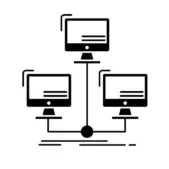In a world shaped by generative AI, cloud-native infrastructures, and remote-first collaboration, businesses are redefining what it means to be digitally mature. While tech-forward companies and startups adapt rapidly, traditional organizations face a pivotal choice: evolve or risk falling behind. To remain competitive, companies must embrace and accelerate digital transformation.
Yet many businesses recognize they aren’t structured to lead digital innovation alone. Rather than building entirely new internal capabilities, they extend their reach by partnering with external digital experts. For these partnerships to succeed, internal collaboration and organizational readiness are critical. Even the most talented digital agency can’t deliver transformative results without a committed, aligned, and digitally capable client organization.
If your organization is planning a digital initiative (or has struggled to realize ROI on past efforts), the journey begins with self-reflection. This article explores what it means to be an exceptional digital partner and how to identify and address internal challenges that may be holding you back.

The Biggest Barrier to Digital Innovation Isn’t Technical — It’s Cultural
Many businesses blame failed digital initiatives on legacy technology, misaligned strategy, or poor vendor performance. While those may be factors, they often obscure the true obstacle: a lack of organizational readiness.
Consider this: in McKinsey’s 2024 State of Digital Transformation report, 70% of failed initiatives cite internal resistance to change, not technology, as the root cause. The takeaway? Digital innovation is less about tools and more about people, mindsets, and processes.
These internal challenges might include:
- Limited executive buy-in, causing confusion and lack of urgency among teams
- Business stakeholders issuing directives without understanding technical constraints
- Product owners disrupting timelines by requesting features out of scope
- Organizations claiming to work agile but lacking the discipline to support it
To lead and support successful digital initiatives, companies must evolve their culture, not just their tech stack.
Five Common Cultural Barriers to Digital Innovation
1. Leadership and Vision
Culture starts at the top. Without unified, visionary leadership, organizations struggle to execute cohesive digital strategies. Your executive team must align around a shared vision and communicate it clearly across departments, linking digital goals with each team’s day-to-day work.
Ask Yourself:
- Is our leadership aligned on digital priorities and investment?
- Do we have a clearly defined roadmap for digital initiatives?
- Is our budget focused on innovation or maintenance?
- Have past digital projects delivered measurable impact? Why or why not?
2. Operational vs. Innovative Mindsets
Organizations typically fall somewhere along a spectrum between operational excellence and innovation. Operational cultures prioritize predictability and efficiency. Innovative cultures embrace risk, experimentation, and ambiguity. The challenge is balancing both.
Innovation requires breaking routines, inviting experimentation, and rethinking established processes; which can be unsettling for teams used to “the way we’ve always done things.”
Ask Yourself:
- Is your organization more focused on efficiency or innovation?
- Are your teams empowered to test new ideas?
- Do individual departments (e.g., IT, sales, ops) operate in silos with distinct subcultures?
3. Digital Dexterity of Individuals
Digital transformation doesn’t happen without digitally capable people. Gartner defines digital dexterity as the mindset and skills individuals need to thrive in a digital environment. Today, that includes not only collaboration, adaptability, and business acumen, but also fluency with AI tools, data analysis, and process automation.
Ask Yourself:
- Do our employees possess the digital knowledge and curiosity needed to drive innovation?
- Are we hiring for digital dexterity across all functions?
- Are internal digital champions empowered to lead change?
4. Misaligned Processes
Agile development doesn’t succeed in a vacuum. If your IT team is running sprints, but the rest of the organization follows rigid approval hierarchies or waterfall planning, you’re likely to experience friction.
Cross-functional collaboration, rapid iteration, and shared accountability are foundational to successful digital delivery.
Ask Yourself:
- Are both business and IT teams aligned on agile practices?
- Do we have a unified product development process?
- Are approvals and feedback loops slowing down delivery?
- Do we apply design thinking to frame and solve user problems collaboratively?
5. Readiness to Collaborate with Digital Partners
Digital partnerships work best when both sides come prepared. Even if you aren’t digitally mature, you can still be a great partner by being open, committed, and willing to let your agency lead.
Ask Yourself:
- Can we work transparently and collaboratively with external experts?
- Are we willing to trust and follow the recommendations of our digital partners?
- Do we have the internal structure to support fast-moving project teams?
Six Steps to Becoming a Better Digital Partner
- Start with Leadership Alignment Ensure your leadership team shares a common vision for your digital future. Use that alignment to conduct a candid assessment of your organization’s strengths, weaknesses, and opportunities for improvement.
- Foster a Culture of Digital Innovation Communicate why digital transformation matters, and set expectations for cultural change. Celebrate curiosity, encourage experimentation, and support teams in navigating change.
- Invest in Digital Capability Building Upskill your teams. Implement design thinking practices. Encourage cross-functional collaboration. Promote AI fluency and data-driven decision making.
- Break Down Silos Form cross-functional teams that include both business and technical stakeholders. Foster shared language and goals. Leverage hybrid roles (like product managers or UX strategists) to bridge gaps.
- Let Your Digital Partner Lead Trust is essential. Let your agency guide your organization through the unfamiliar terrain of digital product development. The right partner will challenge and elevate your team.
- Establish Shared KPIs and Accountability Early Define success metrics collaboratively with your digital partner. Align on what outcomes matter most; from business impact and team velocity to customer satisfaction and product adoption.
Hiring a digital agency is a powerful way to accelerate transformation. But to maximize results, you must also build an internal culture that welcomes and supports innovation. Becoming a strong digital partner means being introspective, open to change, and committed to learning.
When your team brings that mindset to the table, your digital partner can do their best work—and together, you can turn ambitious ideas into measurable outcomes. Let’s connect.


